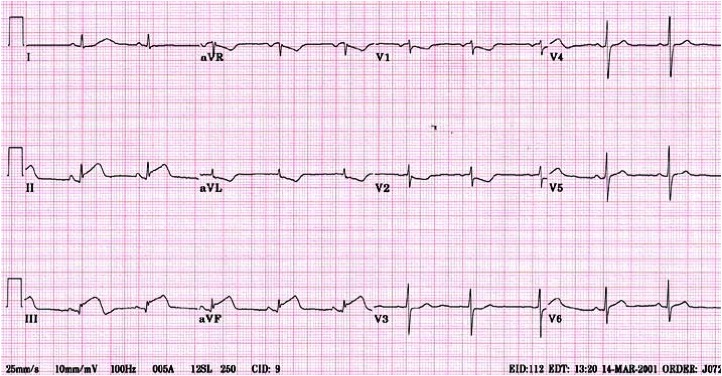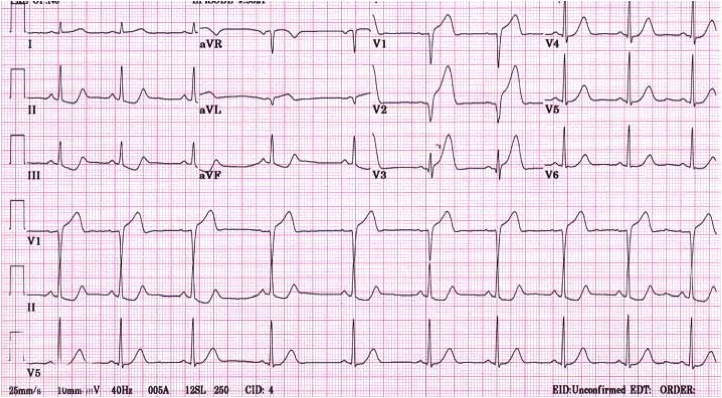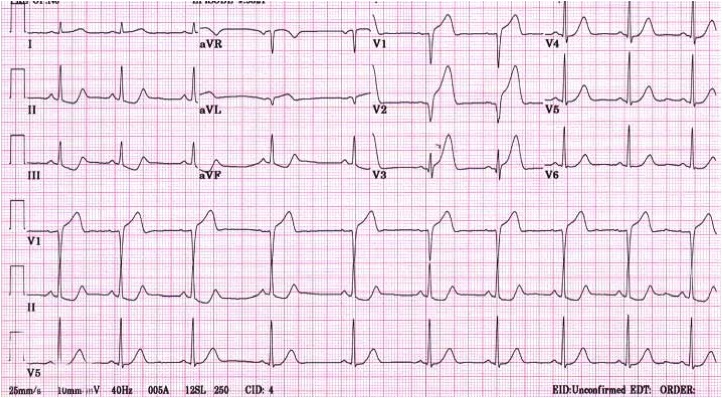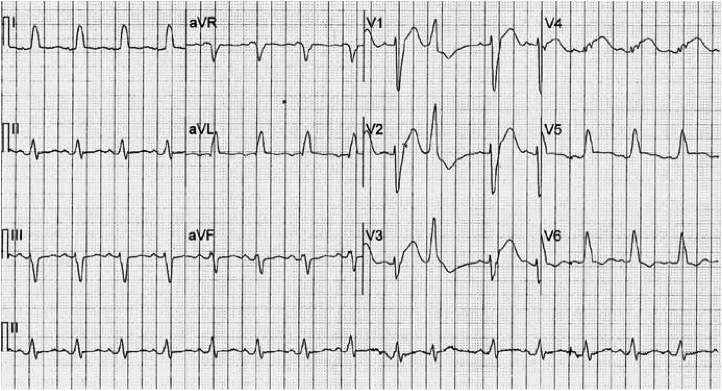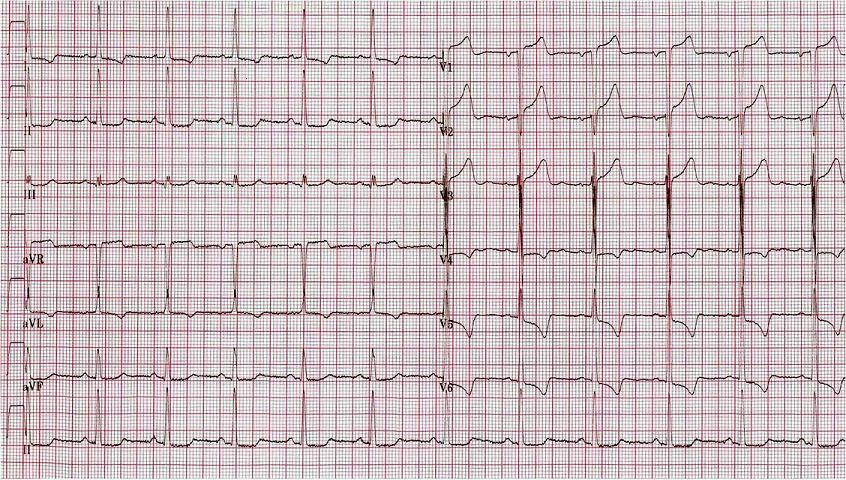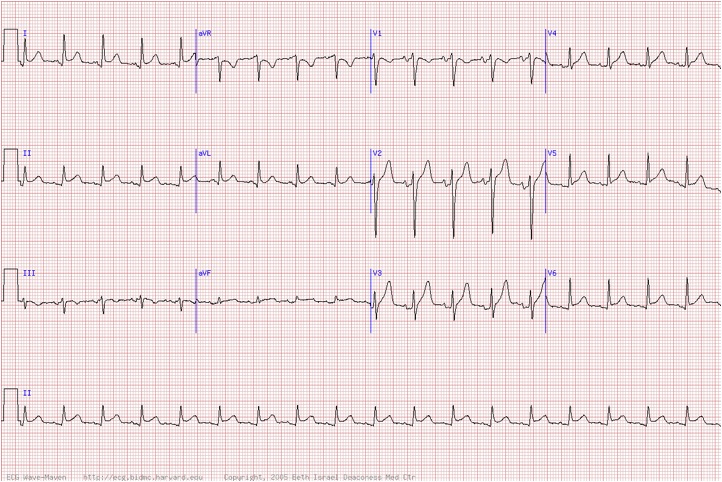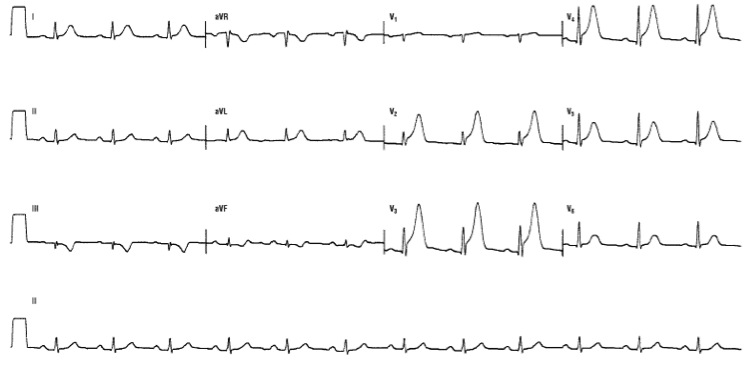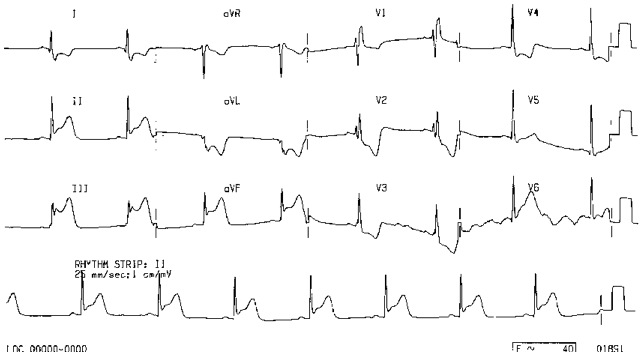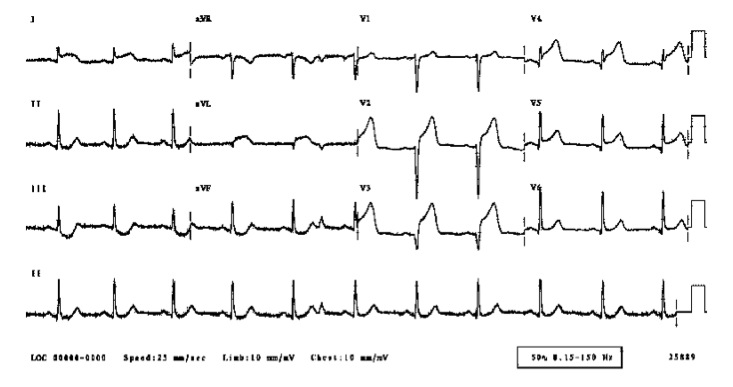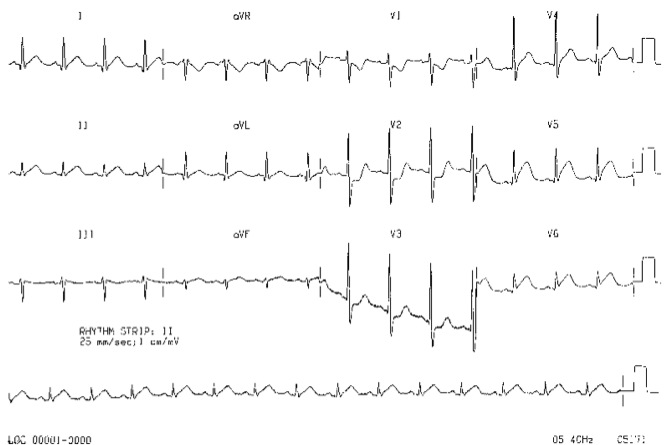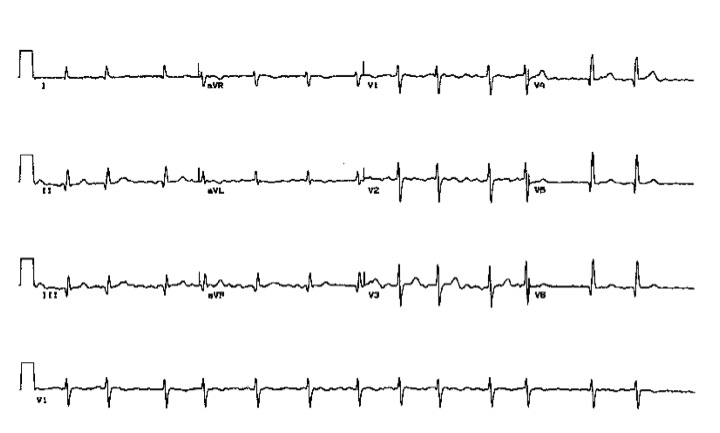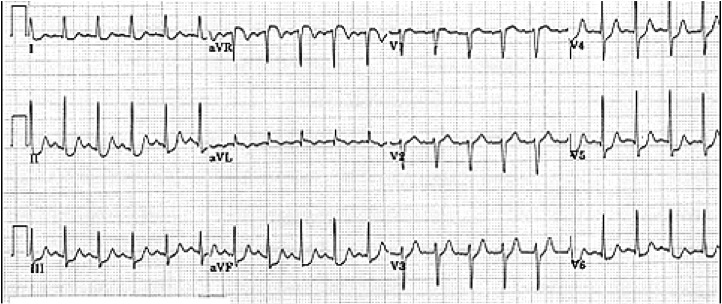ECG Skills Trainer, Part I
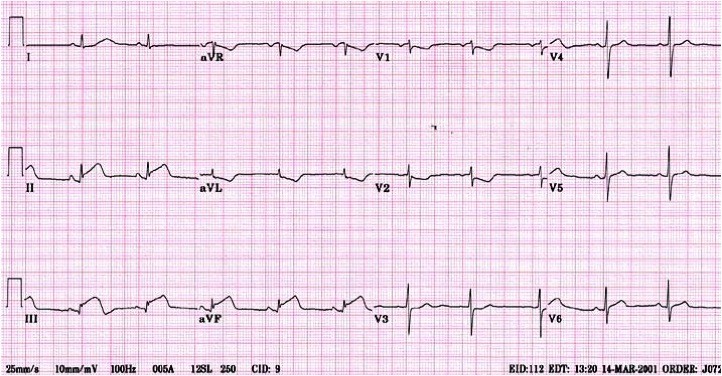
Welcome to the ECG Skills Trainer quiz, part 1.
This quiz is comprised of 11 ECGs, 14 questions. After you submit your test, you will be able to review your replies and see explanations for the questions you missed.
Please make sure to read feedback after completion.
Contact Aashish Didwania, MD, with questions, comments, and concerns.
- 1.
Question 1 of 14:69 year old man with substernal chest discomfort. BP 70 mm Hg. History of HTN.This ECG strongly suggests:
- A.
Acute Inferior Myocardial Infarction
- B.
Acute Inferior and Posterior Myocardial Infarction
- C.
Acute Inferior Myocardial Infarction and Posterior Myocardial Ischemia
- D.
Acute Inferior Myocardial Infarction and Anterior Myocardial Ischemia
Correct Answer
B. Acute Inferior and Posterior Myocardial InfarctionExplanation
Inferior Myocardial Infarction. The ST-depression in V1 and V2 can be:
* reciprocal change anterior
* ischemia (subendocardial injury)
* posterior infarct (subepicardial injury)
Inferior MI tends have reciprocal changes in I and aVL. If ECG done on patients back, would see ST elevation in V1 and V2 if posterior MI. Can be simulated by flipping ECG upside down and over and looking through light. This is posterior infarction. Many times the phrase "inferior infarct with anterior reciprocal changes" is used inappropriately. The actual pathology is "inferior infarct with posterior extension". If still difficult to distinguish from anterior injury, stat Echocardiography can aid in the diagnosis.
View explanation image (copy & paste into your browser):
http://screencast.com/t/YzNkODc2Y2EtRate this question:
-
- 2.
Question 2 of 14:69 year old man with substernal chest discomfort. BP 70 mm Hg. History of HTN.Which is the most common artery involved in this distribution of infarction?
- A.
Left Anterior Descending Coronary Artery
- B.
Obtuse Marginal of Left Circumflex Coronary Artery
- C.
Right Coronary Artery
- D.
Left Main Artery
Correct Answer
C. Right Coronary ArteryExplanation
The patient was in shock with his MI and went immediately to the catheterization laboratory. On the left panel is an RAO image of the diffusely diseased right coronary artery with sluggish distal flow. Look how far posteriorly the artery distributes; hence the inferoposterior MI on ECG. An intraaortic balloon pump was inserted, and because of three vessel disease went to emergency bypass surgery. The RCA is the most common artery involved in Inferior AMI and concurrent Inferior and Posterior AMI. 85% of individuals are right side dominant (which refers to RCA supplying the inferior wall). 15% are left side dominant (Left circumflex supplies the inferior wall).
View explanation image (copy & paste into your browser):
http://screencast.com/t/ZGNjZWI1MmIRate this question:
-
- 3.
Question 3 of 14:51 yr old male with no prior cardiac history presents with mid-sternal chest discomfort.This ECG strongly suggests:
- A.
Acute Inferior Ischemia
- B.
Acute Anteroseptal Infarct
- C.
Acute Anteroseptal Infarct with Inferior Ischemia
- D.
Acute Anteroseptal Infarct with reciprocal changes
Correct Answer
D. Acute Anteroseptal Infarct with reciprocal changesExplanation
ST elevation in a pattern such as seen in this ECG is called acute subepicardial injury. When there is both ST segment elevation and ST-segment depression in the same tracing, look to the leads with elevation for the primary anatomic location of injury. This is true even if the ST depression appears more obvious than the elevation (compare lead III in this ECG with V3, for example). The ST depression seen in the inferior leads is the reciprocal change that typically appears over the wall opposite the injury site.
Infarction is inferred when there is ECG evidence of necrosis; i.e., when pathologic q-waves develop. Look at leads V1 through V3. There is a tiny r-wave that precedes the S in V1 (this is normal). There is no r-wave in V2 and hence we call this a QS complex (in V2, this is abnormal). The embryonic q-wave in V3 is also abnormal indicating early necrosis also.
The red V-shape drawn between the QRS and the ST-segment in V3 is to highlight a shape we think implies that this man's injury is very acute, an excellent opportunity for intervention.
View explanation image (copy & paste into your browser):
http://screencast.com/t/NThkNDgwRate this question:
-
- 4.
Question 4 of 14:51 yr old male with no prior cardiac history presents with mid-sternal chest discomfort.Which is the most common artery involved in this distribution of infarction?
- A.
Left Anterior Descending Coronary Artery
- B.
Obtuse Marginal of Left Circumflex Coronary Artery
- C.
Right Coronary Artery
- D.
Posterior Descending Artery
Correct Answer
A. Left Anterior Descending Coronary ArteryExplanation
Infarction of the anterior wall of the left ventricle usually is caused by occlusion of the LAD or its major diagonal branch. The hemodynamic problems that the patient encounters depend on the extent of the myocardium that is compromised. If the infarct affects 20% to 25% of the left ventrical, the ventricle can no longer empty adequately. As the infarct enlarges, end-diastolic pressures rise, with resultant pulmonary edema.Rate this question:
-
- 5.
Question 5 of 14:81 year old woman presents with substernal chest pain. History of hyperlipidemiaWhat are the defining features of Complete Left Bundle Branch Block?
- A.
Monophasic large R-wave in I and V6 + Monophasic large S-wave in V1
- B.
Monophasic large S-wave in I and V6 + Monophasic large R-wave in V1
- C.
Monophasic large R-wave in I and V6 + Monophasic large Q-wave in V1
- D.
Monophasic large Q-wave in I and V6 + Monophasic large R-wave in V1
Correct Answer
A. MonopHasic large R-wave in I and V6 + MonopHasic large S-wave in V1Explanation
The QRS should be 120 or more ms wide (with the rhythm being supraventricular in origin). The ECG represents CLBBB because of the monophasic wide R-wave in lead I and lead V6 and because the QRS is primarily a large wide S-wave in lead V1.
Additional findings are repolarization abnormalities. Secondary repolarization abnormalities are expected in CLBBB, CRBBB, LVH, RVH, and QRS complexes of either a ventricular or paced origin. Secondary repolarization abnormalities are in the direction opposite the main QRS deflection in that lead.
View explanation image (copy & paste into your browser):
http://screencast.com/t/MGI5NzZkMRate this question:
-
- 6.
Question 6 of 14:81 year old woman presents with substernal chest pain. History of hyperlipidemiaThe ST segment shows:
- A.
Secondary repolarization abnormalities in chest leads
- B.
Acute lateral MI in chest leads (I, aVL, V4-6)
- C.
Acute anterior MI in chest leads (V1-3)
- D.
Acute anterolateral MI
Correct Answer
D. Acute anterolateral MIExplanation
There is ST elevation in leads (I, aVL, V4 - V5) and the ST-shift is in the same direction as the QRS deflection. This is abnormal and indicates a primary rather than secondary repolarization abnormality in the face of CLBBB.
Be cautious in interpreting ischemia or infarction in the presence of LBBB. But there are times where the ECG will be absolutely diagnostic, as is the case in the lateral leads of this ECG.
There is also ST-elevation in LBBB and the elevation is in the opposite direction as the main QRS deflection that it is likely to be secondary to the LBBB. Primary injury should be suspected if the magnitude of ST-elevation is >5 -7mm discordant to the QRS deflection. Look at the ST-elevation from V3 in the current ECG. This finding in the anterior lead along with findings note above in the lateral lead are concerning for acute anterolateral MI. In the setting of chest pain with or without enzyme elevation, emergent cardiac evaluation would be essential.
View explanation image (copy & paste into your browser):
http://screencast.com/t/Y2JhZDVkMjQtRate this question:
-
- 7.
Question 7 of 14:61 year old man reports non-exertional burning in the chest intermittently for last 6 months.The ST segment shows:
- A.
Secondary repolarization abnormalities in precordial and inferior leads
- B.
Acute anteroseptal MI
- C.
Lateral wall ischemia
- D.
Anterior wall ischemia
Correct Answer
A. Secondary repolarization abnormalities in precordial and inferior leadsExplanation
The rhythm is sinus with a rate just above 75. Axis is normal at ~40 degrees. Most striking are the high QRS voltages. The large S wave in V2 and the R wave in V5. These are indicative of left ventricular hypertrophy.
LVH Criteria:
Sokolow-Lyon: (S in V1) + (R in V5 or V6) > 35mm
Cornell: (R in aVL) + (S in V3) >24mm in men, or >20mm in women
Of further interest is the "strain" pattern of ST-T that accompanies these high QRS voltages. The ST segment opposes the primary direction of the QRS complex, appearing in all precordial leads.
Secondary repolarization abnormalities are expected in CLBBB, CRBBB, LVH, RVH, and QRS complexes of either a ventricular or paced origin. Secondary repolarization abnormalities are in the direction opposite the main QRS deflection in that lead. The ST segment elevation in V1-3 will be concave up with an asymmetric upright T wave. The ST segment depression in V4-6, I and aVL will be down sloping with an inverted T wave.
Recognizing whether these could be ischemic changes still requires the context of the patients symptoms and ideally an old ECG for comparison. In the setting of low clinical markers, atypical symptoms and a strain pattern fitting the distribution of high QRS voltages, one can more accurately conclude ST-T changes are a benign strain pattern.Rate this question:
-
- 8.
Question 8 of 14:77-year old woman with rheumatoid arthritis new onset chest pain, and dyspnea. The ECG suggests:
- A.
Acute antero-lateral myocardial infarction
- B.
Early repolarization variant
- C.
Acute pericarditis with effusion
- D.
Systemic hypothermia with Osborn waves
- E.
Hyperkalemia
Correct Answer
C. Acute pericarditis with effusionExplanation
There are diffuse ST elevations (I, II, aVL, aVF, V2-V6). While this could raise the possibility of an antero-lateral infarction in the distribution of the LAD, the associated PR segment deviations (elevated PR in aVR; depressed in V3-V6) help identify the etiology. An elevated PR and depressed ST in aVR are very suggestive. Borderline low voltage and sinus tachycardia raise question of pericardial effusion, rule out cardiac tamponade.
Low voltage in the limb leads is defined as a QRS amplitude of < 5 mm in all limb leads, and low voltage in the precordial leads is defined as a QRS amplitude of < 10 mm in all precordial leads.
Eisenberg, MJ et al The diagnosis of pericardial effusion and cardiac tamponade by 12-lead ECG. Chest 1996;110,318-324
On echocardiogram, a small to moderate effusion was present without hemodynamic compromise. In situations of large pericardial effusions, low voltage and electrical alternans can be seen on ECG. Electrical alternans as seen on this rhythm strip indicates the heart undulating in the effusion with each beat.
View explanation image (copy & paste into your browser):
http://screencast.com/t/MDYwYTkyNTRate this question:
-
- 9.
Question 9 of 14:65-year old man brought in to ED with syncopal episode while practicing Aikido.The ECG suggests:
- A.
Hyperkalemia
- B.
Hyperacute anterolateral MI
- C.
Intracranial Hemorrhage
- D.
Acute anterior MI
Correct Answer
B. Hyperacute anterolateral MIExplanation
This is a rare occurrence, but one with which you should be intimately familiar -a hyperacute AMI. It occurs during the initial period of the AMI and is a transient finding. It is rare because patients rarely present that quickly to a doctor. Note how tall the T waves appear. They are symmetrical, tall, and broad. The patient will usually have chest pain or pressure, or an anginal equivalent such as dyspnea, diaphoresis, or an indigestion feeling.
This patient was having a hyperacute anteroseptal AMI with lateral extension. Look at III and aVF; there are slight depressions in the ST segments consistent with reciprocal changes. The differential diagnosis of these T waves includes intracranial hemorrhage and hyperkalemia. Keep these in mind. The transition in the precordial leads occurs early and the Z axis lies about 10 degrees anteriorly. The prominent R wave is caused by RVH in this case, not a posterior wall AMI. A PWMI would present with ST depressions and inverted T waves rather than ST elevations and hyperacute, positive T waves.
View explanation image (copy & paste into your browser):
http://screencast.com/t/YjMyMTJlNTAtRate this question:
-
- 10.
Question 10 of 14:A 55 year old man with 4 hours of "crushing" chest pain. The ECG suggests:
- A.
Acute anterior MI
- B.
Acute lateral MI
- C.
Acute inferior MI
- D.
Acute posterior MI
- E.
Old MI
Correct Answer
C. Acute inferior MIExplanation
* ST elevation in the inferior leads II, III and aVF
* Reciprocal ST depression in the anterior leadsRate this question:
-
- 11.
Question 11 of 14:A 63 year old woman with 10 hours of chest pain and sweating. The ECG suggests:
- A.
Acute anterior MI
- B.
Acute lateral MI
- C.
Acute inferior MI
- D.
Acute posterior MI
- E.
Old MI
Correct Answer
A. Acute anterior MIExplanation
* ST elevation in the anterior leads V1 - 6, I and aVL
* Reciprocal ST depression in the inferior leadsRate this question:
-
- 12.
Question 12 of 14:A 60 year old woman with 3 hours of chest pain. The ECG suggests:
- A.
Acute anterior MI
- B.
Acute lateral MI
- C.
Acute inferior MI
- D.
Acute posterior MI
- E.
Old MI
Correct Answer
D. Acute posterior MIExplanation
* (hyperacute) the mirror image of acute injury in leads V1 - 3
* (fully evolved) tall R wave, tall upright T wave in leads V1 -3
* usually associated with inferior and/or lateral wall MIRate this question:
-
- 13.
Question 13 of 14:A 53 year old man with Ischemic Heart Disease. The ECG suggests:
- A.
Acute anterior MI
- B.
Acute lateral MI
- C.
Acute inferior MI
- D.
Acute posterior MI
- E.
Old MI
Correct Answer
E. Old MIExplanation
* a Q wave in lead III wider than 1 mm (1 small square) and
* a Q wave in lead aVF wider than 0.5 mm and
* a Q wave of any size in lead IIRate this question:
-
- 14.
Question 14 of 14:70 year old man with chest discomfort. This ECG strongly suggests:
- A.
Subendocardial ischemia
- B.
Lesion of the circumflex artery
- C.
Posterior wall transmural injury
- D.
Acute pericarditis
- E.
Early repolarization
Correct Answer
A. Subendocardial ischemiaExplanation
ST segment depression is a nonspecific abnormality that must be evaluated in the clinical context in which it occurs. In a patient with angina pectoris ST depression usually means subendocardial ischemia and, unlike ST elevation, is not localizing to a particular coronary artery lesion.
Etiologies of ST Depression:
- Normal variants or artifacts:
* Pseudo-ST-depression (wandering baseline due to poor skin-electrode contact)
* Physiologic J-junctional depression with sinus tachycardia (most likely due to atrial repolarization)
* Hyperventilation-induced ST segment depression
-Ischemic heart disease:
* Subendocardial ischemia
* Non Q-wave MI
* Reciprocal changes in acute Q-wave MI (e.g., ST depression in leads I & aVL with acute inferior MI)
-Nonischemic causes of ST depression:
* RVH (right precordial leads) or LVH (left precordial leads, I, aVL)
* Digoxin effect on ECG
* Hypokalemia
* Mitral valve prolapse (some cases)
* CNS disease
* Secondary ST segment changes with IV conduction abnormalities (e.g., RBBB, LBBB, WPW, etc)
Summary of all EKGs with pearls (copy & paste into your browser):
http://cms.feinberg.northwestern.edu/bin/w/t/ECG%20Quiz%20I%20Summary%20Table.docxRate this question:
-
Quiz Review Timeline +
Our quizzes are rigorously reviewed, monitored and continuously updated by our expert board to maintain accuracy, relevance, and timeliness.
-
Current Version
-
Mar 21, 2023Quiz Edited by
ProProfs Editorial Team -
Sep 22, 2010Quiz Created by
Northwestern
 Back to top
Back to top



